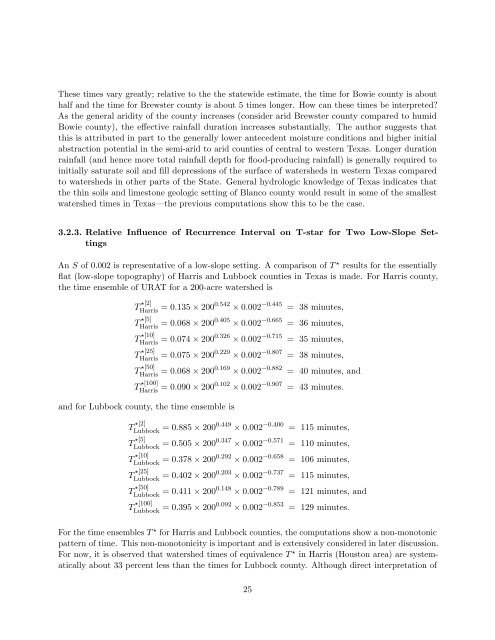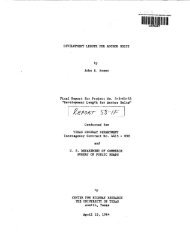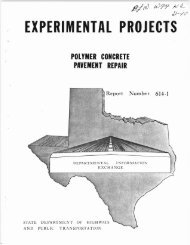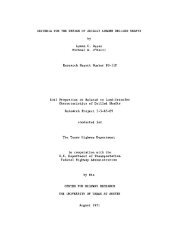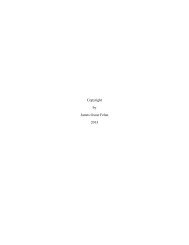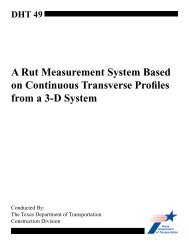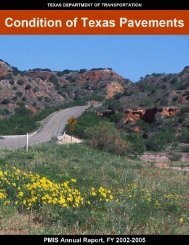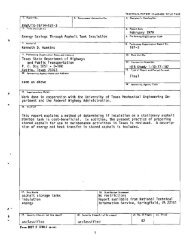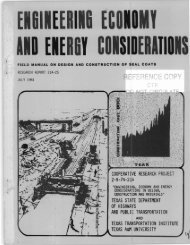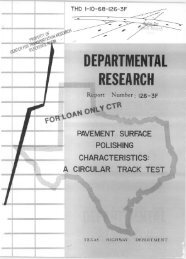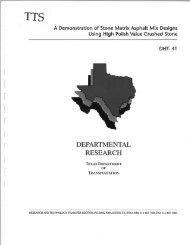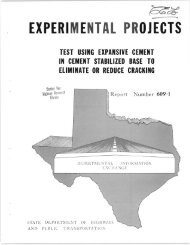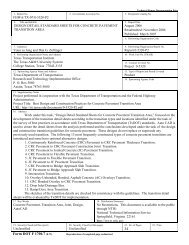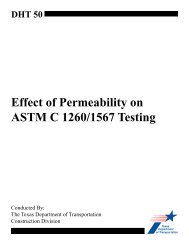Use of Rational and Modified Rational Method for ... - CTR Library
Use of Rational and Modified Rational Method for ... - CTR Library
Use of Rational and Modified Rational Method for ... - CTR Library
You also want an ePaper? Increase the reach of your titles
YUMPU automatically turns print PDFs into web optimized ePapers that Google loves.
These times vary greatly; relative to the the statewide estimate, the time <strong>for</strong> Bowie county is about<br />
half <strong>and</strong> the time <strong>for</strong> Brewster county is about 5 times longer. How can these times be interpreted?<br />
As the general aridity <strong>of</strong> the county increases (consider arid Brewster county compared to humid<br />
Bowie county), the effective rainfall duration increases substantially. The author suggests that<br />
this is attributed in part to the generally lower antecedent moisture conditions <strong>and</strong> higher initial<br />
abstraction potential in the semi-arid to arid counties <strong>of</strong> central to western Texas. Longer duration<br />
rainfall (<strong>and</strong> hence more total rainfall depth <strong>for</strong> flood-producing rainfall) is generally required to<br />
initially saturate soil <strong>and</strong> fill depressions <strong>of</strong> the surface <strong>of</strong> watersheds in western Texas compared<br />
to watersheds in other parts <strong>of</strong> the State. General hydrologic knowledge <strong>of</strong> Texas indicates that<br />
the thin soils <strong>and</strong> limestone geologic setting <strong>of</strong> Blanco county would result in some <strong>of</strong> the smallest<br />
watershed times in Texas—the previous computations show this to be the case.<br />
3.2.3. Relative Influence <strong>of</strong> Recurrence Interval on T-star <strong>for</strong> Two Low-Slope Settings<br />
An S <strong>of</strong> 0.002 is representative <strong>of</strong> a low-slope setting. A comparison <strong>of</strong> T ⋆ results <strong>for</strong> the essentially<br />
flat (low-slope topography) <strong>of</strong> Harris <strong>and</strong> Lubbock counties in Texas is made. For Harris county,<br />
the time ensemble <strong>of</strong> URAT <strong>for</strong> a 200-acre watershed is<br />
T ⋆[2]<br />
Harris = 0.135 × 2000.542 × 0.002 −0.445 = 38 minutes,<br />
T ⋆[5]<br />
Harris = 0.068 × 2000.405 × 0.002 −0.665 = 36 minutes,<br />
T ⋆[10]<br />
Harris = 0.074 × 2000.326 × 0.002 −0.715 = 35 minutes,<br />
T ⋆[25]<br />
Harris = 0.075 × 2000.229 × 0.002 −0.807 = 38 minutes,<br />
T ⋆[50]<br />
Harris = 0.068 × 2000.169 × 0.002 −0.882 = 40 minutes, <strong>and</strong><br />
T ⋆[100]<br />
Harris = 0.090 × 2000.102 × 0.002 −0.907 = 43 minutes.<br />
<strong>and</strong> <strong>for</strong> Lubbock county, the time ensemble is<br />
T ⋆[2]<br />
Lubbock = 0.885 × 2000.449 × 0.002 −0.400 = 115 minutes,<br />
T ⋆[5]<br />
Lubbock = 0.505 × 2000.347 × 0.002 −0.571 = 110 minutes,<br />
T ⋆[10]<br />
Lubbock = 0.378 × 2000.292 × 0.002 −0.658 = 106 minutes,<br />
T ⋆[25]<br />
Lubbock = 0.402 × 2000.203 × 0.002 −0.737 = 115 minutes,<br />
T ⋆[50]<br />
Lubbock = 0.411 × 2000.148 × 0.002 −0.789 = 121 minutes, <strong>and</strong><br />
T ⋆[100]<br />
Lubbock = 0.395 × 2000.092 × 0.002 −0.853 = 129 minutes.<br />
For the time ensembles T ⋆ <strong>for</strong> Harris <strong>and</strong> Lubbock counties, the computations show a non-monotonic<br />
pattern <strong>of</strong> time. This non-monotonicity is important <strong>and</strong> is extensively considered in later discussion.<br />
For now, it is observed that watershed times <strong>of</strong> equivalence T ⋆ in Harris (Houston area) are systematically<br />
about 33 percent less than the times <strong>for</strong> Lubbock county. Although direct interpretation <strong>of</strong><br />
25


